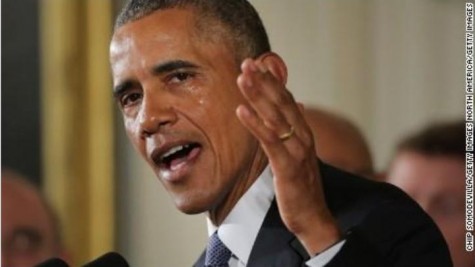The Cheers and Jeers of the Executive’s Executive
February 5, 2016
 The podium of the East Room has been privy to many a groundbreaking gatherings: orations, speeches, pleas, press conferences, inaugurations, and even on standby as presidents have lay in state. Designed to act as the “Public Audience Chamber,” there’s no doubt that it was in fact the whole of America who heard the news of what was announced by President Obama in the room last Tuesday. Addressing a room full of attentive press, loyal administration members, resolute activists, and impassioned loved ones’ of victims, President Obama unveiled his outline for action on an issue that’s long been one of subdued importance on his agenda: the state of the nation’s gun control.
The podium of the East Room has been privy to many a groundbreaking gatherings: orations, speeches, pleas, press conferences, inaugurations, and even on standby as presidents have lay in state. Designed to act as the “Public Audience Chamber,” there’s no doubt that it was in fact the whole of America who heard the news of what was announced by President Obama in the room last Tuesday. Addressing a room full of attentive press, loyal administration members, resolute activists, and impassioned loved ones’ of victims, President Obama unveiled his outline for action on an issue that’s long been one of subdued importance on his agenda: the state of the nation’s gun control.
This subject is nothing new to politics; in fact, it’s one that is increasingly polarizing. “Mass shooting “ has, tragically, become a phrase that we all know too well. And, when the frequency of these events ranks in higher than the number of days in a year, signs point to there being a problem. (See here for our article on these attacks in America, why they’re happening, and what can be done to stop it.) The divide isn’t in the issue of gun violence, either: the fact that these senseless deaths need to stop is a shared human acknowledgement, no matter the political affiliation. The point of the split is how to remedy this rampancy. Some call for the tightening of background checks; some call for reform on the front of the mental illness that many of the culprits of these attacks suffer from; still others call for the restriction of gun ownership. Yet, the opposition to each of these ideas is so strong from the iconoclast- not helped with bipartisanship seeming to be at an all-time high- that there have been no major federal laws passed to modify the state of the nation’s arms possession since the Violent Crime Control and Law Enforcement Act (better known as the “Assault Weapons Ban”, which banned new semiautomatic assault weapons for civilians and reformed juvenile handgun laws). With his last year in office, it seems that President Obama intends to throw attempts at concession with Congress to the wind, choosing instead to pursue the more passionate struggles of he and the Democrats, with that of guns holding one of the top spots. It seems that the president tapped in fully to this emotion, too, pausing to wipe away tears in recounting the events of the tragedy of Sandy Hook, declaring “Every time I think about those kids, it gets me mad,” then adding after a poignant moment, “and by the way, it happens on the streets of Chicago [the hometown where the politician began his career] every day.” The president also made a point to further detail the senselessness of this violence, voicing that “each time this comes up, we are fed the excuse that common-sense reforms like background checks may have stopped the last massacre, or the one before that, or the one before that, so why bother trying? I reject that thinking- we can’t stop every act of violence, every act of evil in the world. But maybe we could try to stop one act of evil, one act of violence.”
Comprised of four major focuses, the White House Press Secretary released on their site that “the President and Vice President are committed to using every tool at the Administration’s disposal to reduce gun violence… [and] announcing a series of commonsense executive actions designed to”:
- Expand background checks for buyers. Essentially, in the words of the White House, “if you’re in the business of selling firearms, you must get a license and conduct background checks.” According to the Bureau of Justice, the background check system has prevented more than two million guns from falling to the wrong hands. Additionally, the Bureau of Alcohol, Tobacco, Firearms and Explosives (ATF) and Federal Bureau of Investigation (FBI) plan to work in coordination to overhaul the background check system. The hope for these improvements include non-stop processing of these backgrounds (as the NICS receives about 63,000 a day, this one could be helpful), along with improving the notification of local authorities at attempts by prohibited persons’ illegal attempts to buy a gun and the employment of over 230 additional examiners and staff to assist in processing these checks.
- Make communities safer from gun violence. Placing a greater surveillance, of sorts, on the local efforts of oversight to arms ownership, the President has already allocated the funds to go about this- the 2017 fiscal year budget includes funding for about 200 new ATF agents and investigators that will help to enforce the gun laws of the area. Realizing that their efforts can’t be restricted to the physical world, the ATF has also established an Internet Investigation Center, intended to track unlawful digital firearms trafficking. Furthermore, it’s this establishment that has four billion dollars allocated towards it, with new personnel, to enhance the National Integrated Ballistics Information Network. It’s also this group who is now finalizing a rule that will ensure dealers who ship guns notify law enforcement if their guns are lost or stolen in transit.
- Increase mental health treatment and reporting to background check systems. It’s not just a reform on the availability of the firearms themselves. With the National Center for Biotechnological Information reporting that nearly 60% of assailants in mass shootings since 1970 displayed symptoms of mental illness- but, pointedly, not any leading cause for such- the Administration has proposed a $500 million investment to increase the ease of access to mental health care. There are also changes being made on the disclosure of these illnesses in regards to gun purchases or ownership. The Social Security Administration has said that it will require information about beneficiaries forbidden from possessing a firearm for mental health reasons, and the Department of Health and Human Services is in the final stages of removing laws that bar states from reporting relevant information about individuals prevented from possessing a gun for mental problems.
- Shape the future of gun safety technology. Within this realm of the order, the President has directed the Departments of Defense, Justice, and Homeland Security, among others, to participate in research of gun safety technology- with ideas ranging from fingerprint scanners to radio-frequency identification to microstamping technology.
Within his address, Obama made a point to insist that his actions were not a plot to confiscate Americans’ guns, in a likely attempt to win over the minds of those who are pro-gun in the U.S. “I believe in the Second Amendment, there written on paper, that guarantees that right to bear arms… But I also believe that we can find ways to reduce gun violence consistent with the Second Amendment.” He was also sure to bring the attention back to Congress, calling on the legislative branch to impose these new gun control measures and change the tune that they took on the President’s tougher gun bill in 2013. “The folks in this room,” the President affirmed, “will not rest until Congress does. Because once Congress gets on board with common-sense gun safety measures, we can reduce gun violence a whole lot.” But, he contends, “we also can’t wait until we have the Congress that’s in line with the majority of Americans, and there are actions within my legal authority that we can take to reduce gun violence and save more lives.”
Though he may have been met with a standing ovation from the White House audience and claim the majority of America as behind efforts of reform, not everyone has been so receptive to the ideas. Republican Speaker of the House, Paul Ryan of Wisconsin, declared that the president’s actions “will no doubt be challenged in the courts… [and] can be overturned by a Republican President… From day one, the President has never respected the right to safe and legal gun ownership that our nation has valued since its founding… His words and actions amount to a form of intimidation that undermines liberty.” On the opposite side of the spectrum, Democratic frontrunner Hillary Clinton vowed in New Hampshire soon after Obama revealed this plan that if elected, she will “take on the fight” and continue Obama’s gun control push, tweeting thanks to Obama “for taking a crucial step forward on gun violence. Our next president has to build on that progres- not rip it away.”
There should be no surprise that the public opinion towards Obama’s proposal is just as diverse. Based on a Quinnipiac University poll in December (rumors have been swirling about Obama proposing restructure for a couple months now), 89% of those surveyed overall support expanding the reaches of background checks, along with 87% of Republicans and 86% of Independents, being additionally backed in 84% of all gun-owning households. A few days after the president made his executive order, Rasmussen Reports conducted another survey and found that 58% of likely U.S. voters believe the government should only do what Congress and the President agree on in regards to gun control, while only 34% of those polled believe that Obama should take action alone if Congress doesn’t approve of his proposed initiatives. Currently, 45% believe that America needs tighter gun control laws, but the greater majority at 50% disagree. In general, it seems that voters tend to oppose further gun control laws, except during brief periods after high-profile shootings- seen during the likes of the Virginia Tech and Sandy Hook shootings. Unsurprisingly, the survey discovered that 73% of Democrats are in support of stricter gun control, whereas 76% of Republicans and 54% of those unaffiliated with parties disagree. Whether or not these measures will even make a difference appears rocky, as well: 21% say that the president’s executive order will reduce mass shootings in America, while 59% disagree and say it will not affect the number of mass shootings (20% are still unsure). Equally as telling is the fact that 62% of Americans on both sides of the aisle don’t trust the government to fairly enforce gun control laws.
So where does that leave the United States? Hard to tell. With Obama on the way out of the Oval Office, the actions he decides to take in his last year are fairly confidently working towards what he wants as the agenda- no stigma in trying to get re-elected. As an executive order, the declaration holds the power of the law with the ability to sidestep Congress. It can, of course, be retracted if deemed unconstitutional by the Court, but the likelihood of this? Well… only time will tell. Until then, I wouldn’t expect any unregistered major arms deals in your area.



